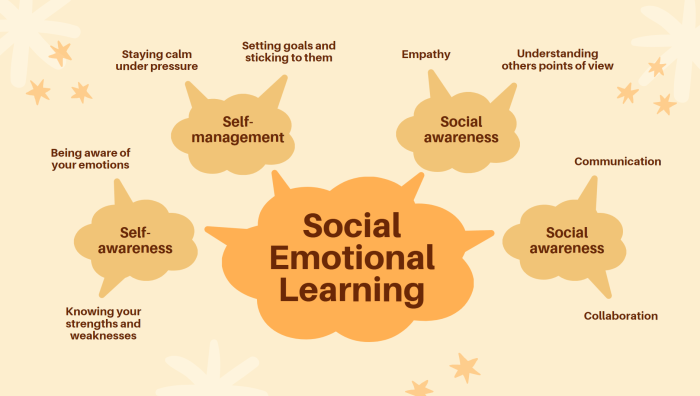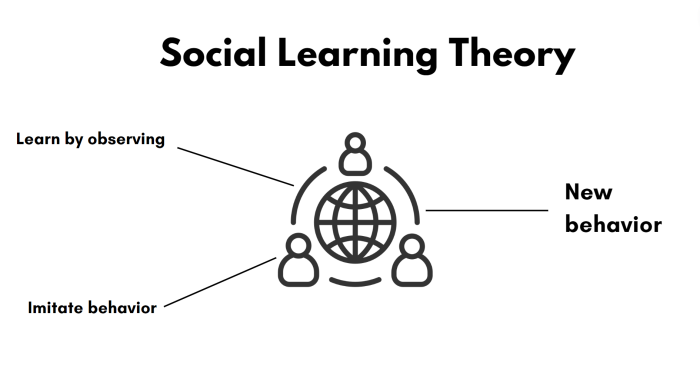
 Data Structure
Data Structure Networking
Networking RDBMS
RDBMS Operating System
Operating System Java
Java MS Excel
MS Excel iOS
iOS HTML
HTML CSS
CSS Android
Android Python
Python C Programming
C Programming C++
C++ C#
C# MongoDB
MongoDB MySQL
MySQL Javascript
Javascript PHP
PHP
- Selected Reading
- UPSC IAS Exams Notes
- Developer's Best Practices
- Questions and Answers
- Effective Resume Writing
- HR Interview Questions
- Computer Glossary
- Who is Who
Social Learning Theory with Examples
Humans have always been social animals; they have depended on others to know how to behave and have always learned from one another. All this has never been more true than in the current era, where information is accessible through social media channels.
What is Social Learning Theory?

Social learning theory emphasizes the importance of observing and modeling the behavior of others. It has roots in psychology and sociology and has been used to explain various human behavior, including aggression, altruism, and moral development.
The basic premise of social learning theory is that people learn by observing the behavior of others. If we see someone behaving in a certain way, we are more likely to imitate that behavior. This process is especially important in the development of aggressive and antisocial behavior.
One of the most influential proponents of social learning theory is Albert Bandura. His famous Bobo doll experiments showed that children who saw an adult model acting aggressively towards a Bobo doll were likelier to behave aggressively when allowed to do so.
Another important figure in the history of social learning theory is psychologist Lev Vygotsky. He argued that children learn best by observing and imitating adults who are more skilled than they are. This concept is known as scaffolding and forms the basis for much of modern educational practice.
There are many different applications of social learning theory. It has been used to explain why people conform to group norms, why they engage in criminal activity, and how they develop prejudice and stereotypes. It can also be used to design educational programs that promote pro?social behavior.
Who Uses Social Learning Theory?

There are three main ideas in social learning theory ?
People can learn by observing others.
People are more likely to imitate behavior they see as successful.
People can learn new behaviors through observation and imitation, even if they don't directly experience the consequences of those behaviors themselves.
So, who uses social learning theory? Teachers use it to design lessons and classroom activities. Businesses use it to create training programs and to understand how employees learn best. And parents use it to help their children learn new skills and values.
How does Social Learning Theory Work in the Classroom?
In social learning theory, the focus is on observing and copying the behavior of others. This type of learning can take place in several ways, including but not limited to the following?
Imitating the behavior of someone who is respected or admired
Observing the consequences that come from certain types of behavior
Trying out new behaviors to see how others receive them
In the classroom, social learning theory can be used to help students learn by observing and imitating the behavior of their peers or teachers. For example, if a student sees another student raise their hand to ask a question, they may be more likely to do the same. Or, if a student observes that their teacher always greets each student with a smile at the beginning of class, they may start to do the same.
When Should You Use Social Learning Theory?
So, when should you use social learning theory? Well, it can be useful in several situations - for example, if you want to teach someone a new skill or behavior. It can also be helpful if you want to change an existing behavior that's proving problematic.
Here are some specific examples of when social learning theory can be used -
1. When you want to teach someone a new skill or behavior
If you want to teach someone how to do something - like ride a bike, for instance - social learning theory suggests that they'll learn best by observing others doing it. So, if you're trying to teach someone to ride a bike, it would be helpful to show them somebody else riding one first.
2. When you want to change an existing behavior that's proving problematic
If someone has a behavior causing problems - like smoking, for example - social learning theory suggests that they can learn to stop doing it by observing others who don't smoke. So, if you're trying to help someone quit smoking, it would be helpful to show them somebody else who doesn't smoke and is living happily without cigarettes.
Types of Social Learning Theory
There are three primary types of social learning theory ?
Bandura's Social Learning Theory
Vygotsky's Social Constructivism
Bronfenbrenner's Ecological Systems Theory
Each of these theories has different implications for how people learn and interact with their environment and with each other. Here is a brief overview of each theory ?
Bandura's Social Learning Theory posits that people learn by observing and imitating the behaviors of others. This theory has been used to explain various human behavior, from aggression to altruism.
Vygotsky's Social Constructivism emphasizes the role of culture and language in shaping cognitive development. According to this theory, children learn best when actively constructing their knowledge rather than passively receiving information from others.
Bronfenbrenner's Ecological Systems Theory describes the complex web of relationships between individuals and their physical and social environments. This theory emphasizes the importance of understanding how individual behavior is shaped by the various systems we live (e.g., family, school, and community).
Strategies to Teach with Social Learning Theory
There are a few key ways that teachers can implement social learning theory in their classrooms. First, providing opportunities for students to model desired behaviors is important. This could be done through role?playing activities, video modeling, or simply having students observe and describe a situation where they see the desired behavior is enacted.
Second, providing opportunities for students to practice the desired behavior is important. This could be done through simulation activities, role?playing games, or other hands?on activities.
Finally, providing feedback to students as they are practicing the desired behavior is important. This feedback should be specific and positive and help the student understand how their behavior impacts those around them.
Social Learning Theory Examples
In social learning theory, behavior is learned by observing and imitating others. This type of learning does not require any reinforcement; it is simply a process of copying the behaviors of those around us. While psychologist Albert Bandura first proposed this theory, it has since been expanded upon and applied to many situations.
One well?known example of social learning theory is the Bobo doll experiment. In this study, children were shown a film of an adult behaving aggressively toward a Bobo doll. The children who saw the film later behaved similarly when they were allowed to play with the doll themselves. This demonstrated that children could learn aggressive behavior simply by observing it in others.
Other examples of social learning theory can be seen in real?world situations. For instance, studies have shown that people are more likely to vote if they see their friends and family doing so. Additionally, people are more likely to give blood if they see someone close to them donating blood. Social learning theory can even explain why some people choose to smoke cigarettes or drink alcohol, despite knowing the risks involved ? they have observed others around them engaging in these behaviors and decided to imitate them

